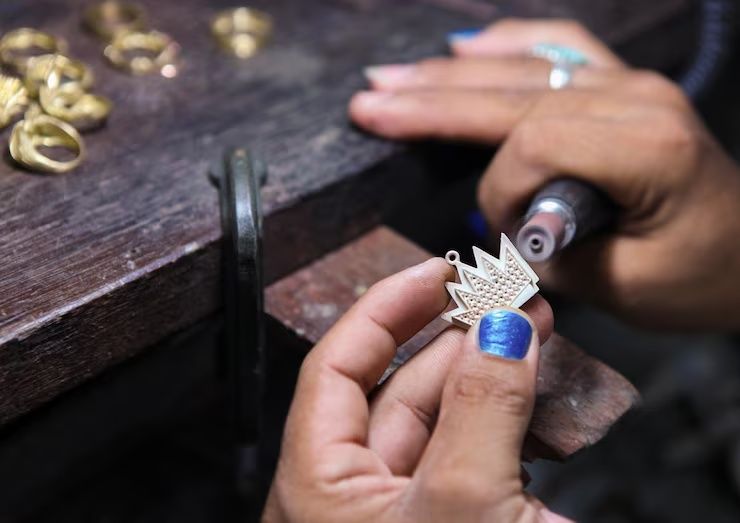Custom jewelry refers to pieces designed and created according to individual specifications, allowing personalization in style, material, and craftsmanship. Unlike mass-produced jewelry, custom pieces are tailored to reflect the wearer’s preferences, occasions, and unique aesthetic choices.
Importance
Custom jewelry holds significance for both personal expression and the jewelry industry:

-
Personalization: Reflects individual taste, heritage, or milestones.
-
Sentimental value: Often associated with life events like engagements, anniversaries, or graduations.
-
Sustainable practices: Allows precise material use, reducing wastage compared to mass production.
-
Market differentiation: Custom designs support creativity and uniqueness in a competitive jewelry market.
-
Cultural and artistic value: Enables incorporation of traditional or innovative design elements into one-of-a-kind pieces.
For consumers, custom jewelry represents a combination of personal expression, craftsmanship, and tangible memories. For designers, it encourages innovation and collaboration with clients.
Recent Updates
In 2023–2024, several trends have shaped the custom jewelry industry:
-
3D printing and CAD design: Digital tools allow precise design modeling, faster prototyping, and complex customization.
-
Ethical sourcing: Rising consumer awareness promotes the use of conflict-free gemstones and recycled metals.
-
Online design platforms: Virtual customization tools let users design jewelry digitally before production.
-
Minimalist and personalized designs: Simpler, meaningful pieces like initial pendants, engraved rings, and stacking jewelry remain popular.
-
Lab-grown gemstones: Offer sustainable, cost-effective alternatives to natural stones with comparable quality.
-
Global exposure: Social media platforms in 2024 have enabled small jewelry designers to reach international audiences, fostering collaborative custom design trends.
These developments reflect how technology, sustainability, and personalization are reshaping the industry.
Laws or Policies
Custom jewelry is subject to regulations to protect consumers, ensure authenticity, and support fair trade:
-
Hallmarking and certification: Countries like the US, UK, and India require precious metals to meet quality standards.
-
Gemstone disclosure laws: Sellers must provide accurate information about gemstones’ origin and treatment.
-
Consumer protection laws: Govern warranties, return policies, and accurate marketing descriptions.
-
Environmental regulations: Mining and metal processing must comply with sustainable and ethical guidelines.
-
Trade and import regulations: International shipment of precious metals or stones must meet customs and certification requirements.
Adherence to these laws ensures trust, transparency, and ethical practices in custom jewelry creation.
Tools and Resources
Several tools and resources assist designers, clients, and enthusiasts in the custom jewelry process:
-
CAD software: Programs like Rhino, Matrix, and JewelCAD for 3D modeling.
-
Virtual design platforms: Online tools allowing customers to customize rings, necklaces, and bracelets.
-
Gem and metal databases: Information on characteristics, pricing, and sourcing of gemstones and metals.
-
Jewelry-making guides and tutorials: Educational resources for aspiring designers and hobbyists.
-
Certification and grading services: Organizations like GIA (Gemological Institute of America) provide gemstone grading and certification.
-
Industry forums and associations: Offer networking, learning, and design inspiration.
Example Table: Common Custom Jewelry Types and Features
| Jewelry Type | Key Features | Popular Customizations |
|---|---|---|
| Rings | Engagement, wedding, fashion | Engravings, birthstones, metal choice |
| Necklaces & Pendants | Chains, lockets, personalized charms | Nameplates, initials, gemstones |
| Bracelets & Bangles | Cuffs, chain, bead styles | Custom sizing, engraving, charms |
| Earrings | Studs, hoops, drops | Gemstone selection, metal type |
| Brooches & Pins | Decorative or commemorative | Unique design, emblem or motif |
This table highlights how customization options vary by jewelry type, allowing for personalized design flexibility.
FAQs
What is custom jewelry?
Custom jewelry is crafted according to individual specifications, incorporating unique design, materials, and personal preferences.
How is custom jewelry different from mass-produced pieces?
Custom pieces are individually designed and handcrafted, while mass-produced jewelry is standardized and made in bulk.
Can I use online tools to design my jewelry?
Yes, many platforms allow users to create digital designs, select materials, and preview the final piece before production.
Are lab-grown gemstones suitable for custom jewelry?
Absolutely, lab-grown stones offer comparable beauty and durability while being ethically sourced and often more affordable.
Is certification important for custom jewelry?
Yes, certification ensures the quality and authenticity of metals and gemstones, protecting both designers and consumers.
Conclusion
Custom jewelry represents a unique blend of artistry, personalization, and craftsmanship. It allows individuals to express themselves while providing designers the opportunity to innovate and collaborate with clients.
With advancements in digital design, 3D printing, and ethical sourcing, the custom jewelry industry has become more accessible, sustainable, and technologically advanced. Regulations such as hallmarking, certification, and consumer protection ensure safety, authenticity, and trust in the market.
By leveraging modern tools, resources, and informed design practices, both designers and customers can create meaningful, high-quality jewelry that reflects personal taste, celebrates milestones, and supports ethical craftsmanship.